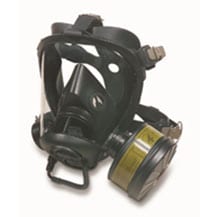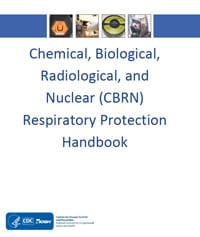CBRN Respirator Approval Resources

Photo courtesy of Survivair
NIOSH approves respirators that protect against chemical, biological, radiological, and nuclear (CBRN) hazards. Respirators with CBRN protections can include:
- Self-contained breathing apparatus (SCBAs)
- Air-purifying respirators (APRs)
- Air-purifying escape respirators (APERs)
- Powered air-purifying respirators (PAPRs) [NIOSH 2019]
NIOSH published the first CBRN standard in 2001, and has since developed performance and design standards, as well as over 60 Standard Testing Procedures, used to evaluate these types of respirators. The NIOSH Respirator Approval Program has issued close to 400 active approvals for respirators with CBRN protections, which emergency responders use.
Refer to the NIOSH resources below to help properly select, use, and maintain CBRN respirators.

NIOSH CBRN Respiratory Protection Handbook
The NIOSH Chemical, Biological, Radiological, and Nuclear (CBRN) Respiratory Protection Handbook provides information to assist emergency responders on selection, use, and maintenance of CBRN respirators. It also provides information to those individuals responsible for managing respirator protection programs or developing training programs.
NIOSH CBRN APR Protection List
As part of a NIOSH-approved CBRN APR, the CBRN canister provides protection against many CBRN hazards that may be present in an emergency event. These hazards are collectively represented in the NIOSH CBRN APR Protection List [NIOSH 2005, NIOSH 2018]. This list was developed through a comprehensive review of technical data and the evaluation of various lists of chemicals that could be used in a terrorist incident [NIOSH 2018]. NIOSH uses this list to categorize CBRN hazards into seven different chemical families and uses 11 chemicals—known as test representative agents—to test the protective ability of a canister claiming CBRN protections. In 2001, NIOSH’s hazard assessment concluded with 139 hazards identified across these seven chemical families [NIOSH 2005, NIOSH 2018]. In a more recent assessment completed in 2018, this list has been expanded to 286 hazards. NIOSH found that its test representative agents remain sufficient to evaluate protections against the additional chemical hazards—some new or emerging—identified during the recent hazard assessment.
- Webpages
- Book
- Cloonan, T.K., Palya, F., Stein, R. Coffey, C.C. Wizner, K.L., Greenawald, L., Szalajda, J.V. (2018). Respiratory Protection for Emergency Responders Handbook of Respiratory Protection: Safeguarding Against Current and Emerging Hazards (429-451). FL: CRC Press.
